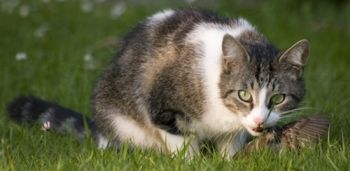
Publisher:
Bonnie King
CONTACT:
Newsroom@Salem-news.com
Advertising:
Adsales@Salem-news.com

~Truth~
~Justice~
~Peace~
TJP
Dec-01-2010 14:52

 TweetFollow @OregonNews
TweetFollow @OregonNews
New Report Puts Economic Impact of Feral Cat Predation on Birds at $17 Billion
Salem-News.comCats will kill wildlife no matter how well they are fed.
 Cat eating a bird by Gaëtan Priour |
(WASHINGTON D.C.) - A new, peer-reviewed report titled, Feral Cats and Their Management from the University of Nebraska—Lincoln, has put the annual economic loss from feral cat predation on birds in the United States at $17 billion. The report analyzes existing research on management of the burgeoning feral cat population – over 60 million and counting -- in the United States, including the controversial practice of Trap, Neuter, Release (TNR).
“This report is a must read for any community or government official thinking about what to do about feral cats. It encapsulates the extensive research on this subject and draws conclusions based on that data. Not surprisingly, the report validates everything American Bird Conservancy has been saying about the feral cat issue for many years, namely TNR doesn’t work in controlling feral cat populations,” said Darin Schroeder, Vice President for Conservation Advocacy for American Bird Conservancy, the nation’s leading bird conservation organization.
“Communities seeking a solution to their feral cat problems need to consider the science on the issue and the well being of animals impacted by feral cats as well as the cats themselves. These other animals – birds especially – don’t deserve to die at the hands of a predator introduced into their environment by irresponsible pet owners. A humane decision-making process on this issue must also recognize that feral cats live short, miserable lives because of disease, other predators, severe weather and traffic hazards. Thus their life expectancy is about one third as long as owned cats,” Schroeder added.
A key finding of the report was the statement by the authors that they do not recommend the TNR method to eliminate colonies of feral cats. In their extensive research, they were unable to find a single real-world example of TNR succeeding in eliminating a feral cat colony.
Some of the many findings of the report include:
Feral cats are invasive and pose a threat to native fauna and public health.
Three separate studies showed that most feral cats (62 to 80 percent) carry the parasite responsible for toxoplasmosis – a condition of special concern to pregnant women.
Cats are responsible for the extinction of at least 33 species of birds.
Feral cats kill an estimated 480 million birds in the U.S. each year (the study did not address the question of bird predation by owned cats. Studies suggest that there are 80 million owned cats in the U.S. and that 43 percent have access to the outdoors. Total cat predation on birds is likely around one billion birds per year, though some analyses suggest much higher figures.)
Feeding feral cats encourages them to congregate which encourages the chances of diseases being transmitted.
The supplemental feeding of feral cats should be prohibited.
Cats kill far more native wildlife species than nuisance (invasive) species.
Cats will kill wildlife no matter how well they are fed.
One reference to TNR success claimed that one particular feral cat colony numbered 920 cats before TNR, and then 678 after. However, when migrations and births were factored in, the colony had actually increased in size -- to 983 cats.
· The life expectancy of a feral cat is 3-5 years as opposed to 15 years for owned cats.
The report can be viewed by going to the following website and then scrolling to report EC1781: http://elkhorn.unl.edu/
American Bird Conservancy (www.abcbirds.org) conserves native birds and their habitats throughout the Americas by safeguarding the rarest species, conserving and restoring habitats, and reducing threats while building capacity of the bird conservation movement. ABC is a 501(c)(3) not-for-profit membership organization that is consistently awarded a top, four-star rating by the independent group, Charity Navigator.
Articles for November 30, 2010 | Articles for December 1, 2010 | Articles for December 2, 2010


googlec507860f6901db00.html


Quick Links
DINING
Willamette UniversityGoudy Commons Cafe
Dine on the Queen
Willamette Queen Sternwheeler
MUST SEE SALEM
Oregon Capitol ToursCapitol History Gateway
Willamette River Ride
Willamette Queen Sternwheeler
Historic Home Tours:
Deepwood Museum
The Bush House
Gaiety Hollow Garden
AUCTIONS - APPRAISALS
Auction Masters & AppraisalsCONSTRUCTION SERVICES
Roofing and ContractingSheridan, Ore.
ONLINE SHOPPING
Special Occasion DressesAdvertise with Salem-News
Contact:AdSales@Salem-News.com
Terms of Service | Privacy Policy
All comments and messages are approved by people and self promotional links or unacceptable comments are denied.
gp December 2, 2010 10:26 am (Pacific time)
How about banning the breeding of any cats? So called cat fanciers profit from the sale of fancy cats but at the same time, shelters are full and many cats are abandoned. Require all pets to be neutered. Male and female. Ban the breeding of cats and dogs for profit.
jimmy December 1, 2010 3:10 pm (Pacific time)
Wow, $35 per bird... are these the same folks that come up with the street value for drug busts?
[Return to Top]©2025 Salem-News.com. All opinions expressed in this article are those of the author and do not necessarily reflect those of Salem-News.com.